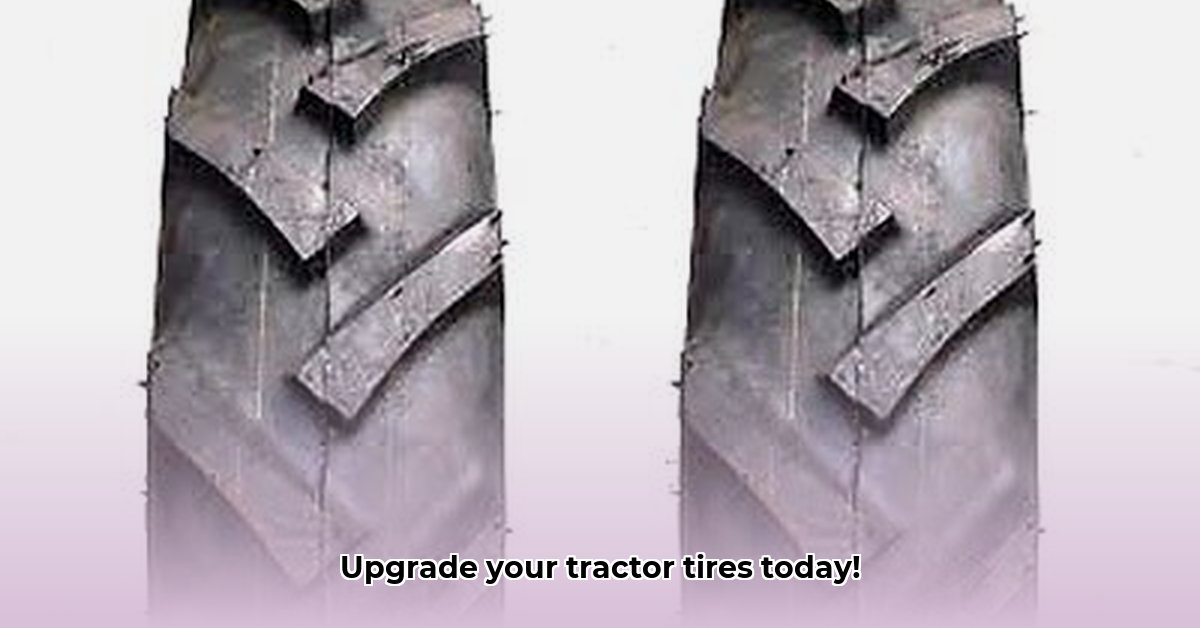
Finding the right 5.00-15 tractor tires is crucial for efficient farming. This comprehensive guide helps you navigate the process, ensuring you choose tires that maximize performance while fitting your budget. We'll cover tire specifications, selection criteria, purchasing options, and maintenance tips. For more options, check out these lawn mower tires.
Understanding 5.00-15 Tractor Tire Specifications
Before selecting your tires, understanding key specifications is vital. These specifications directly impact performance, durability, and cost.
Ply Rating: Strength and Durability
The ply rating indicates the tire's strength and load-carrying capacity. A higher ply rating (e.g., 6-ply) signifies a more robust tire suitable for heavy loads and demanding terrain. Lower ply ratings (e.g., 4-ply) are appropriate for lighter tasks and less rigorous conditions. Higher ply ratings often translate to greater durability, but also typically mean a higher purchase price and may provide a less comfortable ride.
Tread Pattern: Traction and Terrain
The tread pattern significantly affects traction. Deep, aggressive lugs provide superior grip in muddy or loose soil, while smoother patterns are better suited for paved surfaces. Consider your typical working conditions. Do you primarily work in fields, or do you often travel on roads? Match your tread pattern to your terrain type.
Bias-Ply vs. Radial: A Key Distinction
Bias-ply tires are typically less expensive, but radial tires generally offer improved fuel efficiency and a smoother ride. Radials usually boast a longer lifespan, leading to potential long-term cost savings. The ideal choice depends on your budget and priorities. Which is more important to you: an upfront cost saving, or long-term fuel savings achieved through a more efficient tire?
Choosing the Right 5.00-15 Tractor Tires: A Step-by-Step Approach
Selecting the optimal tires involves a careful consideration of several factors. Follow these steps to ensure a well-informed decision:
Step 1: Analyze Your Soil Type.
Different soil types demand different tire characteristics. Heavy clay soils require deep lug treads for maximum grip and prevent compaction, whereas sandy soils might benefit from a shallower tread pattern to minimize soil disturbance.
Step 2: Determine Your Tire Application (Front/Rear).
Front tires typically handle less stress than rear tires, which bear the brunt of pulling power. Consider a lower ply rating for front tires to reduce weight and cost. Rear tires, especially those on tractors often used for heavy pulling, will benefit from higher ply rated tires.
Step 3: Establish Your Budget.
While premium tires have a higher upfront cost, their longer lifespan and improved fuel efficiency can often result in substantial cost savings over time. Consider the price and life expectancy of tires that fit your budget. Remember that initial cost isn't everything; consider long-term operational expenses when deciding which tire is the best value for your needs.
Step 4: Evaluate Your Workload.
Frequent heavy use requires more durable tires with higher ply ratings. Occasional light use permits more flexibility in tire selection, potentially allowing for lower-cost options.
Step 5: Compare Available Models.
Once you've assessed your needs, it's time to compare specific tire models. Use the following table as a guide, remembering to check the manufacturer's specifications for complete and accurate product details.
| Feature | Option A (Example: Bias-Ply, 4-ply, Aggressive Tread) | Option B (Example: Radial, 6-ply, Smooth Tread) | Option C (Example: Radial, 8-ply, Deep Lug Tread) |
|---|---|---|---|
| Ply Rating | 4-ply | 6-ply | 8-ply |
| Construction | Bias-Ply | Radial | Radial |
| Tread Pattern | Aggressive (Deep Lug) | Smooth (Rib) | Aggressive (Deep Lug) |
| Typical Use | Heavy Mud, Rough Terrain | Paved/Moderate Terrain | Extremely Rough Terrain, Heavy Loads |
| Cost | Lower | Moderate | Higher |
| Durability | Lower | Moderate | High |
| Fuel Efficiency | Lower | Higher | Moderate |
Where to Buy Your 5.00-15 Tractor Tires
Purchase tires from reputable dealers to avoid counterfeit products. Check online reviews and consult with other farmers for recommendations on trustworthy suppliers.
Tire Maintenance and Safety: Prolonging Tire Life and Ensuring Safe Operation
Proper tire maintenance is essential for maximizing lifespan and ensuring safety.
Maintain Correct Inflation: Always use the manufacturer's recommended inflation pressure. Underinflation causes premature wear and tear, while overinflation can damage the tire structure.
Regular Inspections: Regularly examine tires for cuts, bulges, embedded objects, and uneven wear. Address any issues promptly to prevent further damage.
Choosing the right 5.00-15 tractor tires is a significant investment in your operation's efficiency and longevity. By following this guide and carefully considering your specific requirements, you can ensure that your tires contribute to optimal performance and minimize downtime. Remember, a well-informed choice paves the way for smoother operations and long-term cost savings.